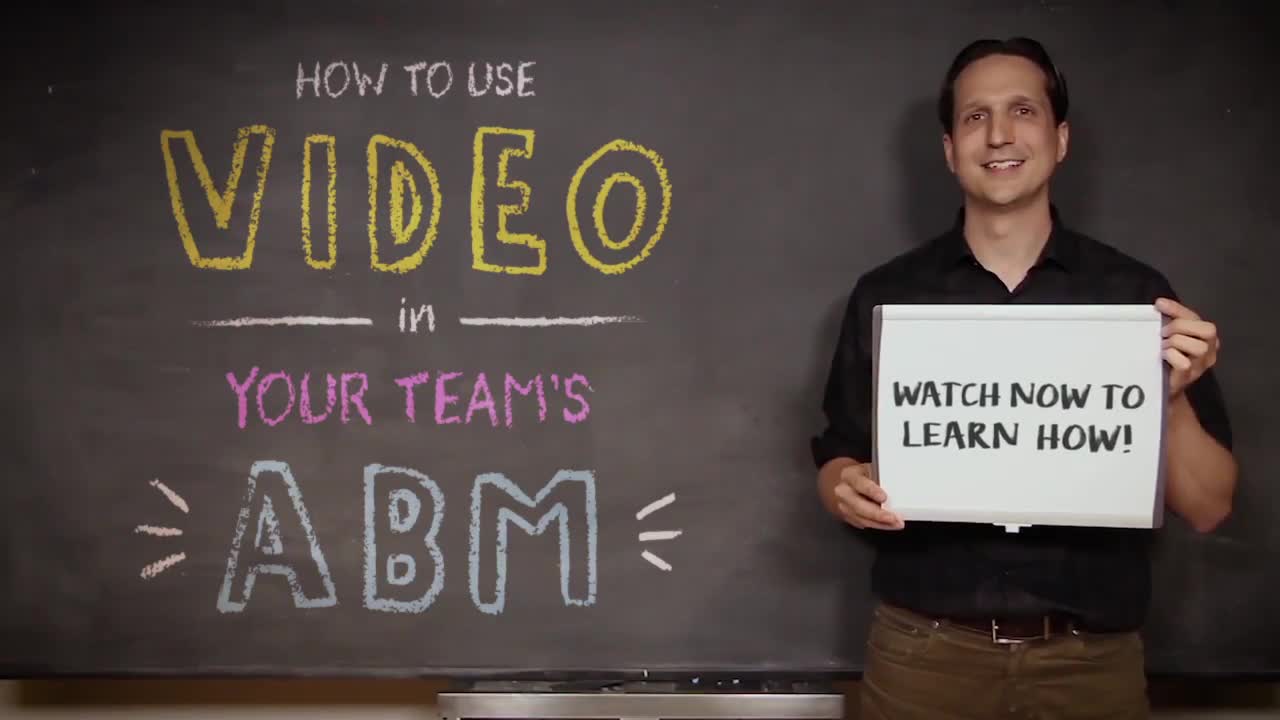Video is an incredibly powerful medium that makes it easier than ever to evoke emotion and forge human connections at scale.
And everyone’s creating it, sharing it, and—most importantly—watching it. From teens on TikTok to brands creating multi-million dollar Super Bowl ads, video is truly everywhere.
For organizations that sell primarily to other businesses, B2B video marketing has emerged as an incredibly effective tactic for reaching, educating, and nurturing potential customers.
Contents1.What is Video Marketing?2.Benefits of Video Marketing3.Video Marketing Strategy4.Video Marketing Storytelling5.Styles and Types of Videos6.Video Distribution Channels7.Video SEO8.Video for Demand Gen9.Video for ABM10.Video Analytics and Video Marketing ROI
What is Video Marketing?
Video marketing is a digital strategy that leverages the power of video to attract, engage, and convert an audience into prospects or customers.
Sometimes referred to as video content marketing, businesses are increasingly using video in every part of the marketing funnel to reach audiences throughout the customer journey.

Download a PDF Version of the Guide
 Not quite ready to get started? Grab a PDF of this guide to print, share with your boss, or save for later.
Not quite ready to get started? Grab a PDF of this guide to print, share with your boss, or save for later.
Get the PDF
Benefits of Video Marketing
Video marketing is all the rage these days, but have you wondered why so many companies have jumped on the proverbial bandwagon?
Video has been proven to increase traffic, engagement, and conversions—but that’s not all. It’s a valuable content format with a lot of benefits.
With video, you can:
Accelerate your company’s revenue growth
Influence buyers with videos designed to help them make decisions
Rank higher in search
Increase traffic to your website
Get more backlinks to pages with embedded videos
Improve conversions
Get more opens and clicks on your email sends
Boost shares on social media
Video Marketing Strategy
While one of the best ways to start with video is simply diving in and creating video content, it’s important to think about the larger strategy driving your use of video.
Your video marketing strategy will provide answers to important questions like:
What are your video marketing goals?
Who’s the target audience who will watch your video content?
What kind of videos are you going to make to reach them?
How much are you going to spend on creating and distributing videos?
Who will be responsible for making videos?
How do videos fit into your other marketing campaigns, account-based marketing strategy, and/or demand generation tactics?
What channels will you embed, share, and otherwise distribute your videos on?
How will you measure the performance of your videos?
The answers to all of these will vary from organization to organization, based on your larger goals as a business and other tactics for achieving them.
The kinds of videos you create (or outsource the creation of) will depend on your target audience and where they spend their time.
While creating your strategy, you should also think about who will be using video. Your marketing, sales, support, and customer service teams (for instance) are all going to want different videos for different purposes.
See how Vidyard can help your business grow with video.
Video Marketing Storytelling
It’s a well-known cliche that a picture’s worth a thousand words. But ask yourself, if that were true, how much would a minute of video be worth?
Visuals pull people in, but story makes them stay until the screen fades to black. And the key to compelling stories is emotion. If you can make your viewers connect emotionally with your video, then you’ve got people who are that much more likely to watch another video and another.
But, how do you connect with people emotionally? First of all, it’s important to remember that making your viewer well up with tears isn’t the only way to engage their emotional self.
Consider how you can evoke happiness, sadness, fear, or even anger through your video storytelling. These are the emotional responses that lead to action.
Luckily, there are some storytelling best practices that can give you a head start:
Make viewers laugh and they’re sure to come back
Get creative—delighting people is a sure way to improve their mood
Tell a complete story, one with a beginning, a middle, and an end
Don’t just tell viewers something, SHOW them
Take your time to come up with a concept that really sings
Tell one story well—don’t try to stuff multiple stories into one video
Keep your videos short and snappy
While it might be tempting, you’ll often find your videos do best when the story isn’t about you—after all, who likes the person at the party who only talks about themselves? (No one, that’s who.)
Learn From the Pros
This explainer video from Uberflip uses humor to capture—and keep—the audience’s attention. It takes the old axiom of “explain it to me like I’m five” and runs with it—with hilarious results.

Styles and Types of Videos
There are TONS of different types of videos to choose from and a long list of video styles you can make each one in, making for nearly endless combinations.
When it comes to styles, consider:
Live action video (includes options like talking head, interviews, etc.)
Animated video
Text overlay video
Live streaming video
360-degree video
Virtual reality video (VR video)
Choose-your-own-adventure video
One-to-one video
Then there are the video types. Oh, the types! There are nine key ones that every business should consider making.
Essential types of video include:
Explainer videos
How-to videos
Promo videos
Thought leadership videos
Webinars and recorded webinars
Case study videos (a.k.a. customer stories or testimonial videos)
Culture videos
Demo videos
Personalized videos
Each video type serves a different purpose and fits in a different part of the marketing funnel. The most popular ones are webinars, demos, and explainer videos, according to the 2019 Video in Business Benchmark Report.
Video Distribution Channels
Video is everywhere. That means you can share it pretty much everywhere too.
When it comes to popular video distribution channels online, you pretty much can’t go wrong with your website. But it’s far from your only choice.
Popular places to use video include:
Website
Landing pages
Email
Blog
Sales assets
Press releases
Partner blogs
Video advertising
YouTube
Social media: LinkedIn, Facebook, Instagram, Twitter, and more
When it comes to sharing video content, the most popular channels are website, social media, and YouTube, according to the 2019 Benchmark Report.
Put Your Videos to Work
Create, host, manage, and share your videos.
Video SEO
You’ve probably heard this one before: The world’s largest search engine, Google, owns the second largest, YouTube.
But what does that tell you about the importance of search engine optimization for video (a.k.a. video SEO)? Quite a lot, in fact. As always, Google was looking ahead when they bought YouTube all the way back in 2006. Video is expected to account for a whopping 82% of all internet traffic by 2022 and we’re well on our way there today.
Google increasingly includes videos in search results—even when searches don’t explicitly request video. When videos do appear in the main results (and not just on the “Videos” tab), they tend to sit near the top of the page. So, it only stands to reason that having video content increases your chances of appearing high on the search engine results pages (SERPs).
Basically, when you’re thinking about SEO for your website, your videos must be part of the equation.
Videos can actually improve your site’s SEO, but not if you’re embedding YouTube videos (using those on your site actually just helps YouTube).
But, that doesn’t mean you should ignore YouTube. Far from. It’s a powerful platform for discoverability (and YouTube videos tend to do well in SERPs to boot). Use YouTube alongside a video platform for business (or self-hosting) to reap the benefits of both.
Just be sure that you don’t use exactly the same title and other metadata in both places. Duplicate content could end up hurting your efforts.
How to Optimize Video for Search
Max out your video SEO by ensuring your videos have all of the appropriate metadata:
Title
Description
Tags
Surrounding text
Transcript
Video for Demand Gen
Video can do a lot more than just attract eyeballs, it can also engage and convert leads—making it a powerful addition to your demand generation strategy.
But… how can you use video for demand gen?
So. Many. Ways.
Add video to your homepage, product pages, and landing pages to capture attention and drive action. Leverage in-video forms to generate leads. Use video CTAs to drive viewers to valuable activities and other conversion points. Gate high-value video content (like webinars) to capture leads. Nurture potential customers with engaging video email content.
But that’s not all.
You can also integrate your video hosting platform with your marketing automation platform (MAP) and customer relationship management (CRM) system to include video viewing data in prospect profiles and include video views in your lead scoring and qualification programs.
Video for ABM
Account-based marketing (ABM) programs thrive on effective targeting and personalization. Video can help with both.
It’s estimated that office workers receive 121 emails every day. Cut through the noise surrounding target accounts by using personalized video to stand out. People are 5x more likely to engage with a personalized video message than with a traditional text-based email.
Focus on sharing video content customized to the target’s industry, geography, or even their specific organization. Spice up your email marketing and nurtures to top accounts by using video. Send video cards—a physical card that contains a small screen with a video of your choosing pre-loaded—to prospects’ offices. Run targeted ads to individuals within a target account and send any who click through to a customized content hub that includes video content unique to their needs.
Watch and Learn
In this Chalk Talk video, Vidyard VP of Marketing Tyler Lessard explains how to use video for ABM to better identify, engage, and convert key accounts.

Meanwhile, tag in your sales team to coordinate their outreach while you’re targeting accounts with marketing content. Get reps to send personal, one-to-one videos to engage individuals from the target account in conversation. Also consider creating marketing-produced videos that the sales team can customize using real time personalization. This can help make your ABM program easier to do at scale.
Video for ABM also gives you an edge in the form of insights. Sales reps can use video engagement data to prioritize their activities, hitting hot leads who are the most interested in your product within minutes of when they engage rather than wasting time on lukewarm prospects.
Connect, Convert, and Close More Deals
Easily create and share 1-to-1 videos.
Video Analytics and Video Marketing ROI
In 2018, 85% of companies reported using some form of video analytics and the number of organizations leveraging intermediate or advanced analytics is on the rise. If you’re not tracking the performance of your video content—and learning from it—you risk being left in the dust.
Video data can provide a lot of insight. Whereas you can typically only indicate if someone viewed or downloaded more traditional content formats (like eBooks and whitepapers), you can pull detailed information for video about level of engagement, such as how long people watched, what parts they rewatched, and more.
Video metrics to watch:
Overall view count
Attention span data
Total click-through rate (CTR)
Link click-through rate (link CTR)
What you track will differ based on your goals for each specific video.
When looking at video’s contribution to wider programs and goals, be sure to look at measurements such as lead generation and qualification, contribution to pipeline, and revenue generated.
Hot Tip
To show the real value of video marketing for your organization, aim to set goals for your video program that indicate how it’s contributing to the company’s larger strategy and key performance indicators (KPIs)
You can get some video metrics from the places where you share your videos, such as YouTube and social media channels. However, to get a complete picture of your video content’s performance—including its impact on larger business goals—you’ll need to use a dedicated video platform.
Solutions built for business can provide real-time data that digs down into specifics such as how individual users interact with each video. Plus, video platforms for business (like Vidyard) integrate with the rest of your tech stack, including your marketing automation platform (MAP) and/or customer relationship management (CRM) system, allowing you to push data through to the places where you’re already doing your reporting.
Video can do a lot for your business—if you use it right. Take the time to think about your strategy and where video can make the biggest impact in your organization. When you’re ready to get going, look for a video platform that’ll make it fast and easy to embed, share, and manage your content.

Download a PDF Version of the Guide
 Not quite ready to get started? Grab a PDF of this guide to print, share with your boss, or save for later.
Not quite ready to get started? Grab a PDF of this guide to print, share with your boss, or save for later.
Get the PDF
The post The Ultimate Guide to Video Marketing appeared first on Vidyard.
Read more: vidyard.com









